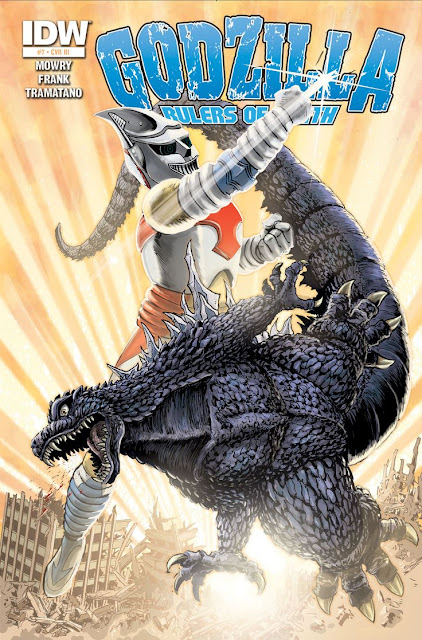For this titanic twentieth entry in Shin Super Robot Sunday, its fitting that the King of the Monsters should get the spotlight.
Toho Studios unleashed Godzilla upon the world in 1954 through director Ishirō Honda and special effects director Eiji Tsuburaya (both well-represented in this survey through The Mysterians, King Kong Escapes, and the Ultraman series). By 1973, Godzilla had already been the star of 12 feature-length movies, going from a metaphor for the shadow of nuclear annihilation to a grumpy wild-card monster that mostly wants to be left alone, to an unlikely superhero that defends the Earth from the likes of King Ghidorah, to a single dad trying to raise his son on Monster Island. It was a long, strange trip through the Shōwa era (named after the era of the Shōwa Emperor, Hirohito), and the 13th Godzilla movie would be a high point for the kid-friendly, lovable superhero version of the character: Godzilla vs Megalon.
Released on March 17, 1973 and directed by Jun Fukuda (himself a veteran director of several Godzila movies such as Ebirah, Horror of the Deep, Son of Godzilla, and Godzilla vs. Gigan) and the special effects direction of Teruyoshi Nakano (a former apprentice of Eiji Tsuburaya's who became the primary effects director for the later Shōwa Godzilla movies).
In 197X, underground nuclear testing near the Aleutian Islands causes significant seismic disturbances that cause havoc on Monster Island. Unbeknownst to the surface world, the tests have devastated the scientifically advanced underground kingdom of Seatopia, which sank below the surface thousands of years ago like the mythical continents of Mu and Lemuria. In Japan, inventor Goro Ibuki, his kid brother Rokuro Ibuki, and buddy Hiroshi Jinkawa get caught up in a plot by Seatopian spies who hijack Goro's recently completed robot, Jet Jaguar, to guide the underground monster Megalon on a path of destruction across the surface.
A lot happens on in the first half of the movie, with fistfights, car chases, Hollow Earth-style civilizations, and the giant insectoid Megalon laying waste to Japan. Its all very pulpy in its sensibilities. After some close calls, Goro is able to regain control of Jet Jaguar and sends him to Monster Island to summon Godzilla to defend the Earth. Godzilla can't fly, though, and Jet Jaguar's AI overrides external control and he grows to giant size to confront Megalon to buy time for the King of the Monsters to swim to shore. In the meantime, the Seatopians sent a signal to the M Space Hunter Nebula Aliens, who send Gigan to Earth as backup for Megalon.
Godzilla really only features in the climactic fight scene of the movie: a two on two tag battle of Megalon and Gigan against Jet Jaguar and Godzilla. Gigan first appeared in 1972's Godzilla vs. Gigan, but Megalon and Jet Jaguar were new entrants to the series.
Megalon is a 55 meter (180 ft) tall giant beetle-like insectoid with a horn that shoots energy beams and two massive drill hands for digging through the Earth's crust. Viewed as a godlike protector by the Seatopians, Megalon isn't very smart, but he is durable, and a well-rounded battler.
The real interesting story, though, centers around Jet Jaguar and his real-world origin. Initially the result of a contest held by Japanese department and grocery store chain Seiyu (now a wholly-owned subsidiary of Wal-Mart) to design a kaiju for the next Toho Studios movie, the winning design was for a brightly colored robot monster called Red Alone which subsequently underwent significant redesigns by Teruyoshi Nakano into Jet Jaguar, with a deliberately garish/obnoxious appearance to set him apart from the many, many, many Ultraman-like giant heroes of the early 70s. The movie project was initially to be called Jet Jaguar vs. Megalon, but in the crowded tokusatsu hero market of the time period, production was halted to add Godzilla and Gigan to the movie for added star power.
Jet Jaguar doesn't have many powers at his disposal compared to an Ultraman (in this movie, at least), but he does have flight, super strength, and incredible durability, as well as the ability to speak with giant monsters and can grow to a height of 50 meters (164 ft).
The movie was successful, making about $20 million at the box office for a cost of $1.2 million, and it would see significant foreign releases, most notably in the US in 1976 where it became a mainstay of home video and matinee TV showings. It earned a divisive position in the Godzilla fanbase for its frequent goofiness, which is also a large part of its cult classic status. In 1991, the movie was featured as an episode of Mystery Science Theater 3000 (the first of two Godzilla movies featured on the show, the other being Godzilla vs The Sea Monster AKA Ebirah, Horror of the Deep), and added to the movie's goofy reputation. In the modern era, the movie has a Criterion Collection release (alongside all of the Shōwa era Godzilla entries), which solidifies the Godzilla vs. Megalon as not just a movie, but as a film.
Haters gonna hate.
Jet Jaguar and Megalon have not made any subsequent movie appearances, but have appeared frequently in multiple Japanese manga, American comics, and video games.
Mexican heavy metal band Jet Jaguar (founded in 2014 in Cancún) released their first full length album, Endless Nights, in July of 2020. Mixing 80's aesthetics, power metal, and a dash of synthwave, the name can't be a coincidence considering Godzilla vs. Megalon's significant international distribution in the 80's and 90's. After all, what's more metal than a giant robot?
Next time on Shin Super Robot Sunday: Toho explores a newer zone: the small screen.
Sources
https://en.wikipedia.org/wiki/Godzilla_vs._Megalon
https://infogalactic.com/info/Godzilla_vs._Megalon
https://wikizilla.org/wiki/Godzilla_vs._Megalon
https://godzilla.fandom.com/wiki/Godzilla_vs._Megalon
https://wikizilla.org/wiki/Teruyoshi_Nakano
https://wikizilla.org/wiki/Jun_Fukuda
https://wikizilla.org/wiki/Jet_Jaguar
https://godzilla.fandom.com/wiki/Jet_Jaguar
https://en.wikipedia.org/wiki/Seiyu_Group
https://godzilla.fandom.com/wiki/Jet_Jaguar_vs._Megalon
https://mst3k.fandom.com/wiki/MST3K_212_-_Godzilla_vs._Megalon
https://www.criterion.com/films/29349-godzilla-vs-megalon




No comments:
Post a Comment